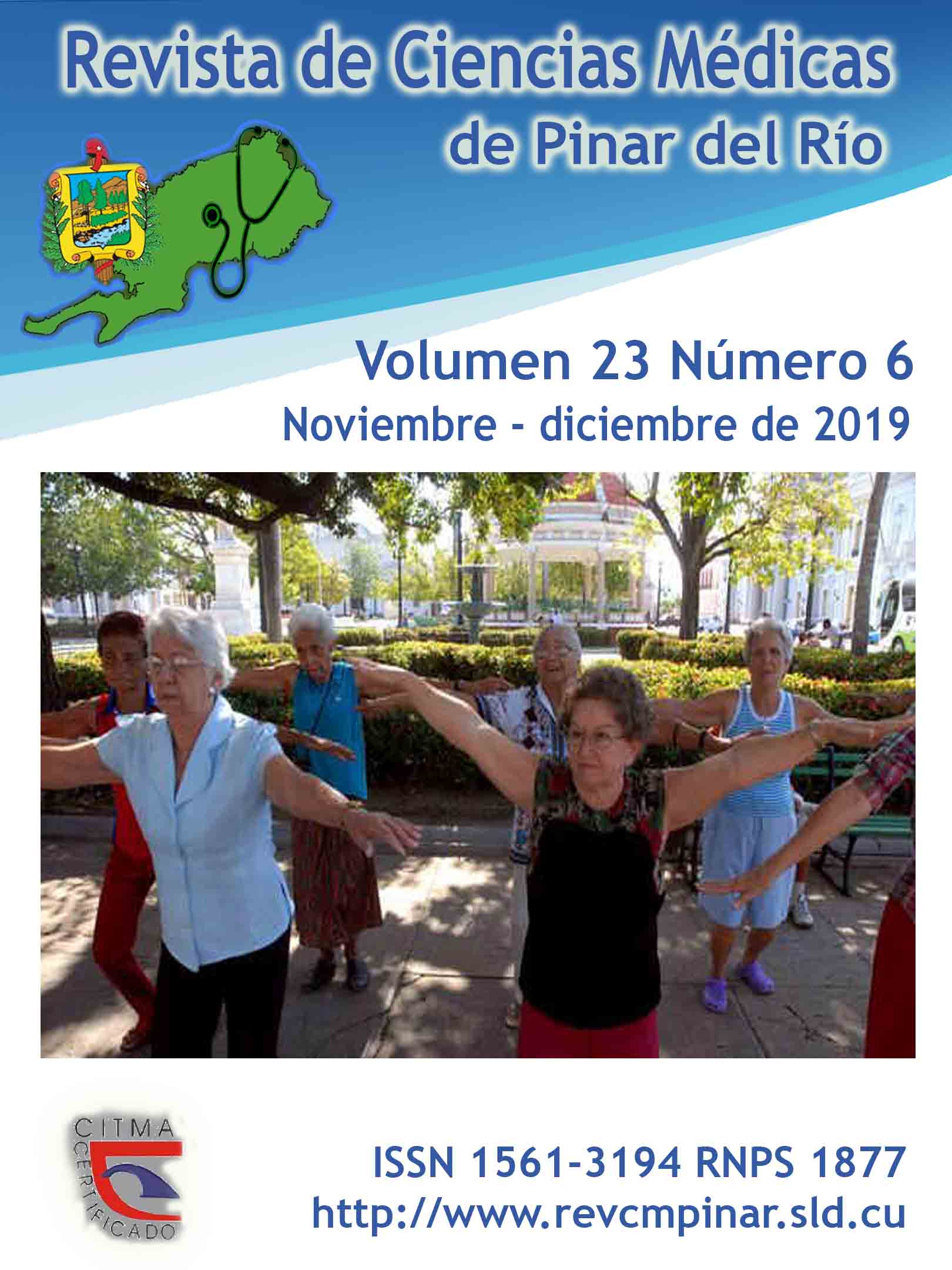Enrique Canals Infante: prominent dentist of Pinar del Río in the War of Independence
Keywords:
HISTORY, DENTISTRY, STUDENTS, HISTORY OF DENTISTRY, RESEARCH.Abstract
Introduction: at crucial moments in the Cuban nation, dentists were present who, by joining the independence struggle, stepped forward to be on the side of duty.
Objective: the contribution of the independence activity of Enrique Canals Infante during the colonial era to the development of the Cuban nation and to the training of a model of professional in dentistry studies.
Methods: a historical research was carried out based on the materialistic-dialectic method. Within the theoretical level, methods such as analysis-synthesis, induction-deduction and historical-logical were applied. At the empirical level, the documentary analysis of 14 bibliographic articles from different databases was carried out between December and January 2019.
Conclusions: Enrique Canals Infante is an outstanding patriot of Pinar del Río dentistry specialty. The characteristics of the colonial period in Cuba and in Pinar del Río were determinant for his significant independence activity in the development of Cuban nationality. His actions transcended the work of other revolutionaries as Isabel Rubio and Antonio Maceo, from his spirit of struggle against foreign domination. Dentistry students are trained in the values of patriotism and humanism inherited from distinctive figures of the profession such as this patriot, with notable contributions to the process of national emancipation; building a model to be followed for the present and future generations of Pinar del Río citizens.
Downloads
References
1. Hernández Salgado AM, Clark Silot M, Menéndez Laria MA, Olivera Valdés M. Estomatólogos cubanos en las guerras contra el colonialismo español: momentos cumbres. Rev Haban Cienc Méd [Internet]. 2013 [citado 16/01/2018]; 12(Supl-5): [aprox. 8p.]. Disponible en: http://scielo.sld.cu/scielo.php?script=sci_arttext&pid=S1729-519X2013000500003
2. Laguardia Martínez J. La clase seminario “José Martí: vida y obras revolucionarias. El ideario martiano”. Una propuesta docente-metodológica. Revista Pedagogía Universitaria [Internet]. 2008 [citado 16/01/2018]; 13(5). Disponible en: https://www.researchgate.net/publication/261758791_La_clase_seminario_Jose_Marti_Vida_y_obra_revolucionarias_El_ideario_martiano_Una_propuesta_docente-metodologica
3. Enríquez Clavero JO, Castellón Sarduy MB, Sarduy Gálvez RM, Elizundia Villavicencio AM, Castillo Viera S. Primeros apuntes sobre la historia de la estomatología en Quemado de Güines. Rev Cubana Estomatol [Internet]. 2015 Oct-Dic [citado 13/01/2018]; 52(4). Disponible en: http://scielo.sld.cu/scielo.php?script=sci_arttext&pid=S0034-75072015000400011
4. Torres-Cuevas E, Loyola Vega O. Historia de Cuba 1492-1898. Formación liberación de la nación. 3ra ed. La Habana: Editorial Pueblo y Educación; 2006.
5. Cantón Navarro J. Historia de Cuba: El desafío del yugo y la estrella. La Habana: Editorial Pueblo y Educación; 2005.
6. Rodríguez Díaz JC. Síntesis de la historia de Pinar del Río. Cuba: Ediciones Loynaz; 2012.
7. García del Pino C, García C. Comandante General de Vueltabajo. La Habana: Editorial Ciencias Sociales; 1990. p. 27-8.
8. Delgado García G. Cuadernos de Historia de la Salud Pública. Cuad Hist Salud Pública [Internet]. 2008 Ene-Jun [citado 01/01/2018]; (103). Disponible en: http://scielo.sld.cu/scielo.php?script=sci_arttext&pid=S0045-91782008000100021
9. Diccionario Enciclopédico de Historia Militar de Cuba (1510-1898). t-1. La Habana: Centro de Estudios Militares de las FAR; 2006.
10. Marrero VM, García V. Leyenda y realidad. La Habana: Editorial de Ciencias Sociales; 1992.
11. González Ribera PL, Hernández Rodríguez D. Isabel Rubio patriota y educadora social. Pinar del Río, Cuba: Ediciones Loynaz; 2014.
12. Giniebra Giniebra E. Información basada en testimonios personales obtenidos mediante entrevistas realizadas por los autores. Pinar del Rio, Cuba; 2018.
13. Rodríguez Herrera M. Cuando Maceo entro en Guane. Periódico Guerrillero; 15 de Enero 1986.
14. Síntesis del plan de estudio de la carrera de Estomatología [Internet]. La Habana: Universidad Ciencias Médicas de la Habana [citado 16/01/2018]. Disponible en: http://instituciones.sld.cu/ucmh/estudios-academicos-autofinanciados/plan-de-estudio-de-la-carrera-de-estomatologia/
15. Medina Téllez MA. La historia de Cuba pertenece al pueblo [Internet]. ACN; 2018 [citado 25/03/2019]. Disponible en: http://www.acn.cu/especiales-acn/31413-la-historia-de-cuba-pertenece-al-pueblo
Published
How to Cite
Issue
Section
License
Authors who have publications with this journal agree to the following terms: Authors will retain their copyrights and grant the journal the right of first publication of their work, which will be publication of their work, which will be simultaneously subject to the Creative Commons Attribution License (CC-BY-NC 4.0) that allows third parties to share the work as long as its author and first publication in this journal are indicated.
Authors may adopt other non-exclusive license agreements for distribution of the published version of the work (e.g.: deposit it in an institutional telematic archive or publish it in a volume). Likewise, and according to the recommendations of the Medical Sciences Editorial (ECIMED), authors must declare in each article their contribution according to the CRediT taxonomy (contributor roles). This taxonomy includes 14 roles, which can be used to represent the tasks typically performed by contributors in scientific academic production. It should be consulted in monograph) whenever initial publication in this journal is indicated. Authors are allowed and encouraged to disseminate their work through the Internet (e.g., in institutional telematic archives or on their web page) before and during the submission process, which may produce interesting exchanges and increase citations of the published work. (See The effect of open access). https://casrai.org/credit/



